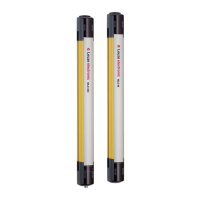What to do if Leuze Security Sensors display error E09?
- JJames SilvaAug 30, 2025
If the Leuze Security Sensors display error E09, it indicates a short circuit against +24 V at OSSD2. To fix this, check the wiring and replace the cable if necessary.

What to do if Leuze Security Sensors display error E09?
If the Leuze Security Sensors display error E09, it indicates a short circuit against +24 V at OSSD2. To fix this, check the wiring and replace the cable if necessary.
What to do if Leuze MLD 300 display error E08?
If the Leuze Security Sensors display error E08, it indicates a short circuit against GND at OSSD2. To solve this, check the wiring and replace the cable if necessary.
What to do if Leuze Security Sensors display error E07?
If the Leuze Security Sensors display error E07, it indicates a short circuit against +24 V at OSSD1. To solve this, check the wiring and replace the cable if necessary.
What to do if Leuze Security Sensors display error E06?
If the Leuze Security Sensors display error E06, it indicates a short circuit against GND at OSSD1. You should check the wiring and replace the cable if necessary.
What to do if Leuze MLD 300 Security Sensors display error E05?
If the Leuze Security Sensors display error E05, it indicates a short-circuit against Vcc at OSSD2. To fix this, check the wiring and replace the cable if necessary.
What to do if Leuze Security Sensors display error E04?
If the Leuze Security Sensors display error E04, it indicates a short-circuit against Vcc at OSSD1. To resolve this, check the wiring and replace the cable if needed.
What to do if Leuze MLD 300 Security Sensors display error E03?
If the Leuze Security Sensors display error E03, it indicates an overload on OSSD2. To fix this, examine the wiring or replace the connected component to reduce the load.
What to do if Leuze MLD 300 display error E02?
If the Leuze Security Sensors display error E02, it means there is an overload on OSSD1. To resolve this, check the wiring or replace the connected component, thus reducing the load.
| Connection Type | M12 connector |
|---|---|
| Protection Class | IP65/IP67 |
| Operating Voltage | 24 V DC |
| Housing Material | Aluminum |
| Resolution | 30 mm |
| Protective Field Height | 300 mm |
| Functions | External device monitoring (EDM) |
| Certifications | CE |
| Outputs | 2 safety outputs (OSSDs) |
| Light Source | LED, infrared |
Clarifies the approved applications and potential improper uses of the safety sensor for risk mitigation.
Outlines the required technical qualifications and experience for personnel handling the safety sensor.
Clarifies the safety responsibilities assigned to both the machine manufacturer and the operator.
Details the prevention of automatic restarts and the requirement for manual confirmation to ensure safety.
Covers the process of temporarily suppressing protective functions to allow object transport.
Explains the use of safety sensors for protecting entry points to hazardous areas, ensuring safety.
Details the precise positioning of transmitter and receiver units for effective protective field coverage.
Explains the formula and necessary parameters for determining required safety distances according to standards.
Guides the calculation of safety distances considering vertical access or reaching over the protective field.
Advises on maintaining distances from reflective surfaces to prevent unintended beam deflection and false triggers.
Covers selecting appropriate mounting methods and suitable locations for sensor installation.
Details the pin configurations of M12 connectors for transmitter, receiver, and transceiver units.
Describes how to select different muting operating modes via pin configurations and bridges.
Provides essential prealignment steps and checks to ensure correct sensor positioning.
Details the precise alignment process using the built-in laser alignment system for optimal performance.
Explains the operation of the start/restart button for system control and error recovery.
Details essential safety and functional tests required before initial startup and after any modifications.
Provides a comprehensive checklist for validating installation and safety compliance before initial use.
Specifies periodic testing procedures to be conducted by qualified personnel to maintain safety.
Guides users on how to approach and diagnose faults using display elements and error messages.